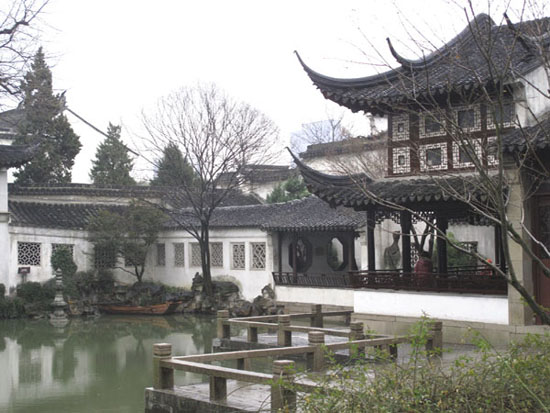
 |
| The architecture next to the pond provides a backdrop of quiet splendor when viewed from the other side. (China Daily/Raymond Zhou) |
Tiptoeing down the hill into the back garden gives me the best feeling about this urban oasis.
It's not the priceless gingko trees, but the pebbled path that stimulates a special tingling in my feet. It can be slippery when wet, yet it provides enough traction to keep balance. The intricate patterns of varying shades of gray are the visual equivalents of New Age music - stimulating and mesmerizing at the same time.
The pond, with its de rigueur rockeries and red fish jostling for food, is a natural hub for tourists. Unless you come on an early morning or a drizzling day, it is a spot for people watching as well.
To get away from the crowd, I aimlessly wandered the back garden along its long corridor. The scenery here is less intense. You don't feel the need to capture every step with a click of the camera.
If crowds are thin, the walk through the main building - from the main entrance to the pond side - should be slowed down and absorbed.
Hopefully this is not done in winter, because this part of China does not have central heating and the houses were so obviously designed for maximizing summer cool. The buildings and rooms are more closely connected than a typical courtyard house or a temple compound. Some of the passages appear quite dim, with a tiny yard inducing a shaft of light.
It is difficult to define the hierarchy in this kind of design aesthetic. But as an abode for a retired official, which was the case with the estate's many owners, it reflects the mentality of the mature and the sophisticated.
You may not want to raise your kids here, but you have a hunch that local Marcel Prousts would find it comfortable to compose their multi-volume tomes and be immune from the hurly-burly of the fast-changing world beyond the brick wall.

















 Man's 20-year habit leads to kidney stone
Man's 20-year habit leads to kidney stone


![]()
